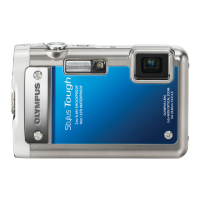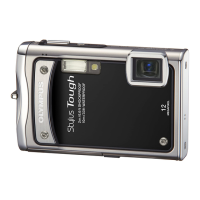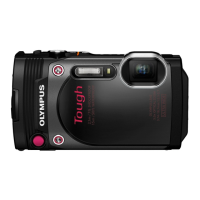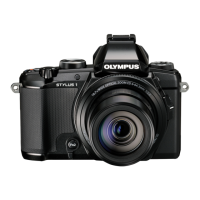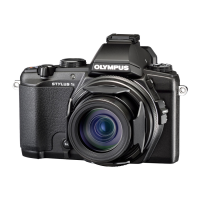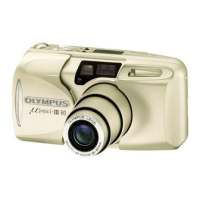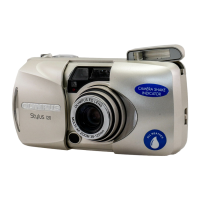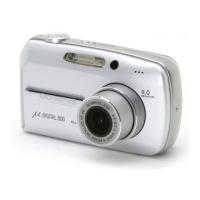Do you have a question about the Olympus STYLUS TOUGH-6000 and is the answer not in the manual?
Identifies the external physical components of the camera.
Instructions on how to securely attach the camera strap.
Steps and information for charging the camera's battery.
How to shoot using Program Auto mode for balanced exposure and settings.
How to navigate and view captured images on the camera.
Process for deleting individual images while in playback mode.
Selecting scene modes for optimal shooting based on the environment.
Using Beauty mode for smoother skin and improved portraits.
Fully automatic shooting mode that selects the best scene for the user.
Instructions for recording video with audio.
Adjusting the shooting range using the zoom button (W/T).
Selecting and using the camera's flash modes.
Modifying the overall brightness of the image.
Focusing and shooting subjects at very close distances.
Capturing images with a time delay after pressing the shutter.
Utilizing the LED illuminator as an auxiliary light for shooting.
Customizing the on-screen display information.
Accessing and setting menu functions via the FUNC menu.
Accessing specific shooting functions like Panorama and Shadow Adj.
Navigating images using different view modes for selection and detail checking.
Modifying the type of shooting information displayed on the screen.
Setting image size and compression for optimal output quality.
Setting the white balance for accurate color representation.
Adjusting camera sensitivity to light conditions.
Continuous shooting modes like single frame or burst.
Using Fine Zoom for enhanced magnification without quality loss.
Utilizing digital zoom for increased magnification.
Choosing metering modes for accurate exposure measurement.
Setting the camera's focus area for precise focusing.
Adding sound notes to still images.
Adjusting shadow areas for subjects in backlight.
Activating image stabilization to reduce blur from camera shake.
Choosing pre-programmed scene modes for specific shooting conditions.
Automatic shutter release when a smile is detected.
Recording video that includes moments before the shutter is pressed.
Shooting pictures by tapping the camera body in Snow mode.
Stitching multiple images together to form a panorama.
Automatically combining three frames into a panorama.
Manually combining frames into a panorama using a guide.
Combining frames into a panorama using Olympus Master 2 software.
Resetting camera settings to their factory defaults.
Creating and viewing automatic slideshows of images.
Applying automatic image enhancements like red-eye correction.
Applying beauty enhancements to skin and eyes in images.
Adjusting the color tone of images (e.g., Black & White, Sepia).
Resizing images to smaller formats for sharing or email.
Selecting a portion of an image and saving it as a new file.
Embedding a calendar view onto an image.
Generating a montage of 9 frames from a movie.
Preventing selected images from being accidentally erased.
Changing the orientation of images by 90-degree increments.
Recording short audio clips to accompany still images.
Options for erasing images (selected, all).
Storing print preferences like date/time imprint for DPOF.
Completely erasing all data from the internal memory or card.
Backing up internal memory images to an xD-Picture Card.
Selecting the language for menus and error messages.
Customizing the screen and sound displayed when the camera powers on.
Choosing preferred menu screen colors or background images.
Adjusting camera sounds like beeps and shutter clicks.
Displaying the captured image briefly after shooting.
Resetting file naming sequences for new cards or continuity.
Calibrating the camera's sensor and image processing.
Modifying the brightness level of the camera's LCD monitor.
Setting a second time zone for tracking different locations.
Choosing video output format (NTSC/PAL) for TV playback.
Enabling power-saving features to extend battery life.
Enabling the LED illuminator for low-light focusing.
Activating and calibrating tap control for camera operation.
Muting all camera sounds for discreet operation.
Using tap control for functions like flash mode selection during shooting.
Using tap control for navigating images in playback mode.
Calibrating tap sensitivity and intervals for camera control.
Printing images directly from the camera to a PictBridge printer.
Simple printing using the printer's default settings.
Customizing print settings like size, borders, and layout.
Selecting a portion of an image to print.
Setting print preferences on the card for easy printing later.
Making print reservations for individual images.
Setting print reservations for all images on the memory card.
Clearing all existing print reservation data.
Canceling print reservations for specific images.
Information on installing and setting up the OLYMPUS Master 2 software.
Steps to establish a connection between the camera and a computer.
How to launch and begin using the OLYMPUS Master 2 software.
Guidance on using the features and functions of the software.
Methods for transferring images without the OLYMPUS Master 2 software.
Solutions for common camera issues and error messages.
Tips for battery care and maximizing battery life.
Notes on monitor visibility and potential display anomalies.
Information on date/time settings and potential resets.
Miscellaneous tips, including focus operation noises.
Guidelines for cleaning and maintaining the camera's exterior, monitor, and lens.
Details on battery types, charging, and charger usage.
Recommendations for storing the camera during extended periods.
Information on using the AC adapter for continuous power.
Guidance on using chargers internationally with adapters.
Information on xD-Picture Cards and their usage.
List of compatible memory card types.
Instructions for formatting new memory cards before use.
Understanding the indicator for internal memory or card usage.
Methods to maximize storage capacity by managing images.
Instructions for using the microSD card adapter.
Precautions for handling microSD cards and attachments.
Details on the camera's water and shock resistance specifications and limitations.
Pre-use checks and preparations for water resistance.
Post-use care procedures, especially after underwater use.
Specific notes regarding lens cover maintenance and cleaning.
Guidelines for storing the camera and maintaining its water resistance.
General safety warnings regarding electrical shock and product handling.
Important safety instructions for product usage, cleaning, and location.
Safety warnings and precautions for handling the camera safely.
Guidelines to prevent battery hazards like leakage or explosion.
Precautions for using the camera in various environmental conditions.
Notes on LCD monitor behavior and potential display anomalies.
Disclaimers and warranty information from Olympus.
Technical specifications of the camera, including recording system, memory, and dimensions.
Specifications for the LI-50B lithium ion battery.
Specifications for the LI-50C battery charger.
Information on product performance at low temperatures.
Specifications for the microSD card attachment.
| Megapixel | 10 MP |
|---|---|
| Camera type | Compact camera |
| Sensor type | CCD |
| Image stabilizer | Yes |
| Image sensor size | 1/2.33 \ |
| Maximum image resolution | 3648 x 2736 pixels |
| Digital zoom | 5 x |
| Optical zoom | 3.6 x |
| Focal length range | 5 - 18.2 mm |
| Number of aspheric elements | 3 |
| Digital SLR | No |
| Dimensions (WxDxH) | 95.3 x 22.4 x 63.4 mm |
| Aperture range (F-F) | 3.5 - 5.1 |
| Camera shutter speed | 1/2000 - 1/4, 0.5 s |
| Effective sensor resolution | 10000000 pixels |
| Compatible operating systems | Windows 2000/XP/VISTA Mac OS X 10.3 - 10.5 |
| Focal length (35mm film equivalent) | 28 - 102 mm |
| Focus adjustment | Auto |
| Normal focusing range | 0.5 - ∞ m |
| Auto focusing (AF) modes | selective auto focus, single auto focus, spot auto focus |
| Super Macro focusing range | 0.02 - 0.5 m |
| Macro focusing range (tele) | 0.3 - ∞ m |
| Macro focusing range (wide) | 0.1 - ∞ m |
| Light metering | centre-weighted, spot |
| ISO sensitivity | 50, 100, 200, 400, 800, 1600 |
| Flash modes | fill-in, Flash off, Red-eye reduction |
| Flash range (tele) | 0.98 - 2.7 m |
| Flash range (wide) | 0.1 - 4 m |
| Internal memory | 48 MB |
| Compatible memory cards | xd |
| Motion JPEG frame rate | 30 fps |
| Maximum video resolution | 640 x 480 pixels |
| Display diagonal | 2.7 \ |
| Display resolution (numeric) | 230000 pixels |
| USB version | 2.0 |
| Scene modes | beach, Candlelight, Close-up (macro), Cuisine, Documents, dusk, Fireworks, Night, Night landscape, Night portrait, Panorama, party (indoor), Portrait, self-portrait, Sports, Sunset, Underwater, Landscape (scenery) |
| Image editing | resizing, rotating |
| Photo effects | black&white, Sepia |
| White balance | auto, Cloudy, daylight, Fluorescent, Tungsten |
| Camera playback | movie, single image, slide show |
| Image processor | TruePic III |
| Self-timer delay | 12 s |
| Playback zoom (max) | 10 x |
| Product color | Yellow |
| Battery type | LI-50B |
| Battery life (CIPA standard) | 230 shots |
| Cables included | USB |
| Bundled software | OLYMPUS Master 2 |
| Storage temperature (T-T) | -20 - 60 °C |
| Operating temperature (T-T) | -10 - 40 °C |
| Storage relative humidity (H-H) | 10 - 90 % |
| Operating relative humidity (H-H) | 30 - 90 % |
| Depth | 22.4 mm |
|---|---|
| Width | 95.3 mm |
| Height | 63.4 mm |
| Weight | 149 g |

